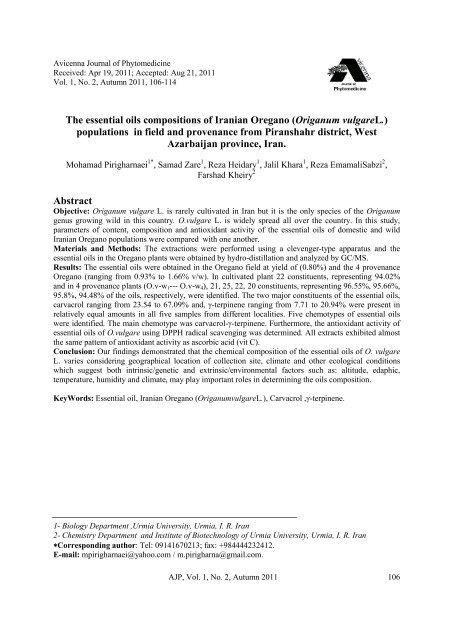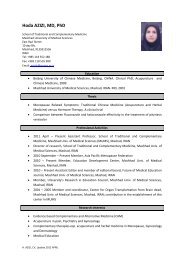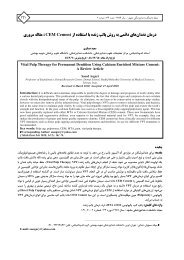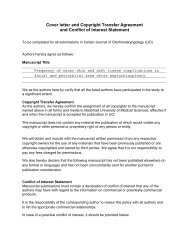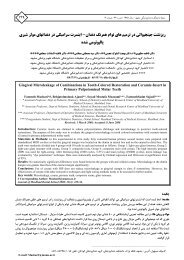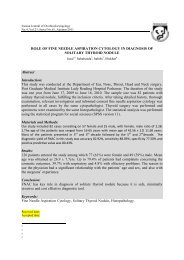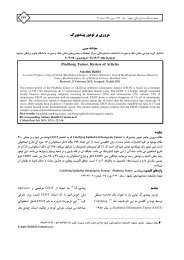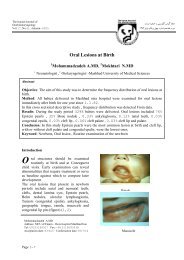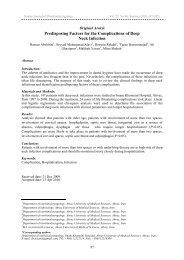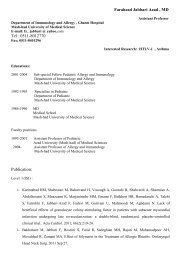The essential oils compositions of Iranian Oregano (Origanum ...
The essential oils compositions of Iranian Oregano (Origanum ...
The essential oils compositions of Iranian Oregano (Origanum ...
Create successful ePaper yourself
Turn your PDF publications into a flip-book with our unique Google optimized e-Paper software.
Avicenna Journal <strong>of</strong> Phytomedicine<br />
Received: Apr 19, 2011; Accepted: Aug 21, 2011<br />
Vol. 1, No. 2, Autumn 2011, 106-114<br />
<strong>The</strong> <strong>essential</strong> <strong>oils</strong> <strong>compositions</strong> <strong>of</strong> <strong>Iranian</strong> <strong>Oregano</strong> (<strong>Origanum</strong> vulgareL.)<br />
populations in field and provenance from Piranshahr district, West<br />
Azarbaijan province, Iran.<br />
Mohamad Pirigharnaei 1* , Samad Zare 1 , Reza Heidary 1 , Jalil Khara 1 , Reza EmamaliSabzi 2 ,<br />
Farshad Kheiry 2<br />
Abstract<br />
Objective: <strong>Origanum</strong> vulgare L. is rarely cultivated in Iran but it is the only species <strong>of</strong> the <strong>Origanum</strong><br />
genus growing wild in this country. O.vulgare L. is widely spread all over the country. In this study,<br />
parameters <strong>of</strong> content, composition and antioxidant activity <strong>of</strong> the <strong>essential</strong> <strong>oils</strong> <strong>of</strong> domestic and wild<br />
<strong>Iranian</strong> <strong>Oregano</strong> populations were compared with one another.<br />
Materials and Methods: <strong>The</strong> extractions were performed using a clevenger-type apparatus and the<br />
<strong>essential</strong> <strong>oils</strong> in the <strong>Oregano</strong> plants were obtained by hydro-distillation and analyzed by GC/MS.<br />
Results: <strong>The</strong> <strong>essential</strong> <strong>oils</strong> were obtained in the <strong>Oregano</strong> field at yield <strong>of</strong> (0.80%) and the 4 provenance<br />
<strong>Oregano</strong> (ranging from 0.93% to 1.66% v/w). In cultivated plant 22 constituents, representing 94.02%<br />
and in 4 provenance plants (O.v-w 1 --- O.v-w 4 ), 21, 25, 22, 20 constituents, representing 96.55%, 95.66%,<br />
95.8%, 94.48% <strong>of</strong> the <strong>oils</strong>, respectively, were identified. <strong>The</strong> two major constituents <strong>of</strong> the <strong>essential</strong> <strong>oils</strong>,<br />
carvacrol ranging from 23.54 to 67.09% and, γ-terpinene ranging from 7.71 to 20.94% were present in<br />
relatively equal amounts in all five samples from different localities. Five chemotypes <strong>of</strong> <strong>essential</strong> <strong>oils</strong><br />
were identified. <strong>The</strong> main chemotype was carvacrol-γ-terpinene. Furthermore, the antioxidant activity <strong>of</strong><br />
<strong>essential</strong> <strong>oils</strong> <strong>of</strong> O.vulgare using DPPH radical scavenging was determined. All extracts exhibited almost<br />
the same pattern <strong>of</strong> antioxidant activity as ascorbic acid (vit C).<br />
Conclusion: Our findings demonstrated that the chemical composition <strong>of</strong> the <strong>essential</strong> <strong>oils</strong> <strong>of</strong> O. vulgare<br />
L. varies considering geographical location <strong>of</strong> collection site, climate and other ecological conditions<br />
which suggest both intrinsic/genetic and extrinsic/environmental factors such as: altitude, edaphic,<br />
temperature, humidity and climate, may play important roles in determining the <strong>oils</strong> composition.<br />
KeyWords: Essential oil, <strong>Iranian</strong> <strong>Oregano</strong> (<strong>Origanum</strong>vulgareL.), Carvacrol ,γ-terpinene.<br />
1- Biology Department ,Urmia University, Urmia, I. R. Iran<br />
2- Chemistry Department and Institute <strong>of</strong> Biotechnology <strong>of</strong> Urmia University, Urmia, I. R. Iran<br />
Corresponding author: Tel: 09141670213; fax: +984444232412.<br />
E-mail: mpirigharnaei@yahoo.com / m.pirigharna@gmail.com.<br />
AJP, Vol. 1, No. 2, Autumn 2011<br />
106
<strong>The</strong> <strong>essential</strong> <strong>oils</strong> composition <strong>of</strong> <strong>Iranian</strong> <strong>Oregano</strong><br />
Introduction<br />
<strong>The</strong> genus <strong>Origanum</strong> belongs to the<br />
family <strong>of</strong> Labiatae and includes many<br />
species that are commonly found as wild<br />
plants in the Mediterranean areas, Euro-<br />
Siberian and Irano-Siberian regions (Skoula<br />
et al., 2002; Aligiannis et al., 2001). A total<br />
<strong>of</strong> 38 <strong>Origanum</strong> species are recognized in the<br />
world. Most <strong>of</strong> the <strong>Origanum</strong> species, over<br />
75%, are growing in the east Mediterranean<br />
sub-region <strong>of</strong> which 16 species are<br />
considered as endemic to the flora <strong>of</strong> Turkey<br />
(Guner et al., 2000; Sahin et al., 2004).<br />
<strong>Origanum</strong> vulgare L. is the only species <strong>of</strong><br />
the <strong>Origanum</strong> genus growing wild in Iran.<br />
O.vulgare L. is widely spread all over the<br />
country, particularly Gilan, Mazandaran and<br />
West Azarbaijan provinces. (SalehiSurmaghi,<br />
2010).<br />
<strong>Origanum</strong> species grow abundantly on<br />
stony slopes and in rocky mountain areas at a<br />
wide range <strong>of</strong> altitudes (0 – 4000 m) (Sahin<br />
et al., 2004; Snogerop, 1971). Due to the<br />
variability in chemical and aroma<br />
characteristics, <strong>Origanum</strong> plants belonging to<br />
different species and ecotypes (biotypes) are<br />
widely used in agriculture as well as in<br />
pharmaceutical and cosmetic industries as a<br />
culinary herb, flavouring substances <strong>of</strong> food<br />
products, alcoholic beverages and perfumery<br />
for their spicy fragrance (Aligiannis et al.,<br />
2001; Snogerop, 1971; Sivropoulou et al.,<br />
1996).<br />
<strong>The</strong> <strong>essential</strong> oil <strong>of</strong> oregano is composed<br />
<strong>of</strong> carvacrol and/or thymol as dominant<br />
components, followed by γ-terpinene, p-<br />
cymene, linalool, terpinen-4-ol and sabinene<br />
hydrate (Skoula et al., 2002; D,antuono et al.,<br />
2000). Results <strong>of</strong> various studies indicated<br />
that the antioxidant effects <strong>of</strong> oregano might<br />
be related to the dominant components<br />
including, carvacrol and thymol present in,<br />
its <strong>essential</strong> oil (Lagouri et al., 1999).<br />
<strong>The</strong> quality <strong>of</strong> oregano is determined<br />
mainly by the <strong>essential</strong> oil content and the its<br />
composition. Both parameters may vary<br />
considerably depending on genotypes,<br />
climate conditions and nutrient supply during<br />
the cultivation (D , antuono et al., 2000). For<br />
example, nitrogen fertilization affected the<br />
composition <strong>of</strong> the <strong>essential</strong> <strong>oils</strong> by<br />
increasing the percentage <strong>of</strong> thymol and<br />
carvacrolwith a simultaneous decrease <strong>of</strong> γ-<br />
terpinene and p-cymene in <strong>Origanum</strong><br />
syriacum (Omer, 1999). Studies on oregano<br />
plants in Greece showed that O. vulgare ssp.<br />
hirtum, contained a high amount <strong>of</strong> <strong>essential</strong><br />
oil. <strong>The</strong> content <strong>of</strong> <strong>essential</strong> oil as high as 8%<br />
with carvacrol as dominant component (95%)<br />
was reported for this subspecies (Kokkini<br />
and Vokou, 1989). Because <strong>of</strong> its high<br />
<strong>essential</strong> oil content with high percentage <strong>of</strong><br />
carvacrol, this subspecies which is<br />
systematically and widely cultivated in<br />
Greece is known as “Greek<br />
oregano”(Chatzopoulou et al., 2004). In<br />
Mediterranean countries, O. vulgare var.<br />
creticum was found to contain <strong>essential</strong> oil<br />
with a varying percentages <strong>of</strong> carvacrol<br />
ranging from 3% to 68% (Berna , th, 1997).<br />
<strong>The</strong> composition <strong>of</strong> <strong>essential</strong> <strong>oils</strong> <strong>of</strong><br />
O.vulgare L. spp. vulgare was carefully<br />
analyzed in Italy (Melgari et al., 1995) and<br />
France (Chalchat and Pasquier, 1998). <strong>The</strong><br />
seeds from four localities were studied in<br />
Italy and 4 chemotypes <strong>of</strong> <strong>essential</strong> <strong>oils</strong> were<br />
identified. <strong>The</strong> seeds <strong>of</strong> 70 clones cultivated<br />
in France were collected from different<br />
locations in France and other European<br />
countries and the <strong>essential</strong> <strong>oils</strong> were<br />
classified into six chemotypes (Chalchat and<br />
Pasquier, 1998).<br />
In various studies, it has been<br />
demonstrated that the <strong>essential</strong> <strong>oils</strong> and<br />
extracts composition <strong>of</strong> medicinal plants such<br />
as <strong>Origanum</strong> species showing antimicrobial,<br />
antioxidant and other biological activities<br />
may change according to the differences in<br />
cultivation, origin, vegetative stage and<br />
growing seasons <strong>of</strong> the plants (Deans et<br />
al.,1996; Kustrak et al.,1996; Milos et al.,<br />
2000; Muller-Ribebau et al.,1995).<br />
AJP, Vol. 1, No. 2, Autumn 2011<br />
107
Pirigharnaei et al.<br />
Also, previous studies showed that the other<br />
subspecies <strong>of</strong> O. vulgare L. constitute several<br />
different chemotypes based on their <strong>essential</strong><br />
oil <strong>compositions</strong>. <strong>The</strong> thymol and carvacrol<br />
chemotypes were identified in O.vulgareL.<br />
spp. hirtum (Sivropoulou et al.,1996; Melgari<br />
et al., 1995; Kokkini et al.,1997; Skoula et<br />
al.,1999).<br />
Furthermore, the carvacrol chemotype <strong>of</strong><br />
<strong>essential</strong> oil is characteristic <strong>of</strong> O.vulgareL.<br />
ssp. glandulosum while thymol, sabinenegermacrene<br />
D chemotypes for O. vulgare L.<br />
spp. gracile (Melgari et al., 1995; Leto et al.,<br />
1994). <strong>The</strong> O.vulgare L. spp. viride growing<br />
in Iran, produced linalyl acetate-βcaryophyllene-sabinene<br />
chemotype <strong>of</strong><br />
<strong>essential</strong> oil (Afsharypour et al., 1997), while<br />
carvacrol, γ- terpinene and p-cymene were<br />
characteristics <strong>of</strong> plants cultivated in<br />
Kishenev botanical garden in Russia (Bodrug<br />
et al., 1990). <strong>The</strong> other species <strong>of</strong> the<br />
<strong>Origanum</strong> genus mainly formed the similar<br />
chemotypes as O. vulgare L. <strong>The</strong> major<br />
constituents <strong>of</strong> the <strong>essential</strong> oil <strong>of</strong> O.<br />
laevigatum Boiss. were bicyclogermacrene,<br />
germacrene D and β-caryophyllene (Tucker<br />
and Maciarelle, 1992; Baser et al.,1996). <strong>The</strong><br />
<strong>essential</strong> oil from O. vulgareL. is a complex<br />
mixture containing lipophilic monoterpenes,<br />
<strong>of</strong> which carvacrol and thymol are believed<br />
to be responsible for its antimicrobial<br />
properties (Lambert et al., 2001).<br />
O. vulgare L. is rarely cultivated in Iran<br />
but it is the only species <strong>of</strong> the <strong>Origanum</strong><br />
genus growing wild in the country. O.vulgare<br />
L. is widely found all over the country,<br />
particularly in Gilan, Mazandaran and West<br />
Azarbaijan provinces (SalehiSurmaghi,<br />
2010).<br />
So far, there is no report on the<br />
comparison <strong>of</strong> the yield and composition <strong>of</strong><br />
the <strong>essential</strong> oil for cultivated and wild<br />
species <strong>of</strong> <strong>Iranian</strong> <strong>Oregano</strong> populations in the<br />
literatures. <strong>The</strong>refore, in the present study,<br />
the aerial parts <strong>of</strong> <strong>Origanum</strong> vulgare L. were<br />
collected in the field and 4 habitats in<br />
mountains <strong>of</strong> Piranshahr district as well as<br />
their valley in southwestern <strong>of</strong> west<br />
Azarbaijan. Five chemotypes <strong>of</strong> <strong>essential</strong> <strong>oils</strong><br />
were identified. <strong>The</strong> <strong>essential</strong> <strong>oils</strong> <strong>of</strong> the<br />
Carvacrol-γ-terpinene main chemotype were<br />
found in <strong>Origanum</strong> growing wild and<br />
cultivated populations. All <strong>essential</strong> oil<br />
obtained form these species showed almost<br />
the same pattern <strong>of</strong> antioxidant activity as<br />
ascorbic acid (vit C).<br />
Materials and Methods<br />
Plant materials<br />
O. vulgare L. species were collected from<br />
five different geographical locations in June<br />
2010 pre-flowering stage. Locations and<br />
taxonomical assignments were: (I) Field<br />
(1200m) O.v-F; (II) Gerdrahmat valley<br />
(2200m) O.v-W 1 ; (III) Khezr Abad<br />
forest(1750m) O.v-W 2 ; (IV) Perdanan<br />
mountains (2650m) O.v-W 3 ; (V) Gaderan<br />
highlands (2800m) O.v-W 4 , in Piranshahr<br />
district, west Azarbaijan province, Iran.<br />
<strong>The</strong> taxonomic identification <strong>of</strong> plant<br />
materials was confirmed by a senior plant<br />
taxonomist (Miss Mozhgan Larti), in<br />
Agricultural Research Center, Urmia, Iran.<br />
Collected plant materials were dried in<br />
shadow at room temperature for 5 days, and<br />
the air-dried aerial parts <strong>of</strong> the plant (the<br />
leaves with young stems) were powdered in a<br />
grinder with a 2 mm diameter mesh. A<br />
voucher specimen <strong>of</strong> each population has<br />
been deposited at the Herbarium <strong>of</strong> the<br />
Agricultural Research Center, Urmia, Iran.<br />
Isolation <strong>of</strong> the <strong>essential</strong> <strong>oils</strong><br />
<strong>The</strong> oregano samples <strong>of</strong> at least 30 g <strong>of</strong><br />
the air-dried aerial parts <strong>of</strong> the plants were<br />
hydro-distilled for 2h (3 times) using a<br />
clevenger-type apparatus (Britania pharmacopeia<br />
model), (yield ranging from 0.8% to<br />
1.66% v/w). <strong>The</strong> obtained <strong>essential</strong> <strong>oils</strong> (EO)<br />
were dehydrated over anhydrous sodium<br />
AJP, Vol. 1, No. 2, Autumn 2011<br />
108
<strong>The</strong> <strong>essential</strong> <strong>oils</strong> composition <strong>of</strong> <strong>Iranian</strong> <strong>Oregano</strong><br />
sulphate and after filtration, stored at 4 ◦ C<br />
until tested. (Sahin et al., 2004).<br />
GC–MS analysis conditions<br />
<strong>The</strong> analysis <strong>of</strong> the <strong>essential</strong> oil was<br />
performed using a <strong>The</strong>rmo Finnigan Trace<br />
MS2000 GC- MS, equipped with a HP-5 MS<br />
capillary column (30 m, 0.25 mm i.d, film<br />
thickness 0.25µm). For GC–MS detection an<br />
electron ionization system with ionization<br />
energy <strong>of</strong> 70 eV was used. Helium was the<br />
carrier gas, at a flow rate <strong>of</strong> 35 ml/min.<br />
Injector and detector temperatures were 200<br />
and 250°C, respectively. Column<br />
temperature was initially kept at 120°C for 5<br />
min, then gradually increased to 260°C at a<br />
10°C /min rate. <strong>The</strong> components were<br />
identified based on the comparison <strong>of</strong> their<br />
relative retention time and retention indices<br />
with Wily library data <strong>of</strong> the GC–MS system<br />
and literature data (Adams, 2001).<br />
Antioxidant activity (DPPH assay)<br />
<strong>The</strong> hydrogen atoms or electrons donation<br />
ability <strong>of</strong> the <strong>essential</strong> <strong>oils</strong> were measured<br />
from the bleaching <strong>of</strong> purple coloured<br />
methanol solution <strong>of</strong> DPPH (Figure1). DPPH<br />
radical scavenging activity was determined<br />
as described by Zijia Zhang, et al.,2009, with<br />
a slight modification. Fifty microliter <strong>of</strong><br />
various concentrations <strong>of</strong> the extracts in<br />
methanol was added to 5 ml <strong>of</strong> a 0.004%<br />
methanol solution <strong>of</strong> DPPH. After gentle<br />
mixing and 30 min incubation period at room<br />
temperature, the absorbance <strong>of</strong> the resulting<br />
solutions was measured at 517 nm using a<br />
Biowave S2100 spectrophotometer. <strong>The</strong><br />
percent <strong>of</strong> DPPH inhibition by each oil<br />
sample was calculated using the following<br />
equation:<br />
%I = [Ao-(A s -A 1 )] / Ao ×100 Ao<br />
(Control)=50µl (methanol) +5ml (DPPH) A s<br />
(Extract sample)=50µl (extract) +5ml (DPPH)<br />
A 1 (Blank)=50µl (extract) + 5ml (methanol)<br />
Extract concentration providing 50%<br />
inhibition (IC 50 ) was calculated from the<br />
graph plotting inhibition percentage against<br />
extract concentration. Synthetic antioxidant<br />
reagent, ascorbic acid (Vit C) was used as<br />
positive control and all tests were carried out<br />
in triplicate.<br />
Results<br />
Chemical composition <strong>of</strong> oregano <strong>essential</strong><br />
<strong>oils</strong><br />
Compositions <strong>of</strong> the <strong>essential</strong> <strong>oils</strong> isolated<br />
from all the five localities are reported in<br />
Table 1. <strong>The</strong> extractions were performed in a<br />
clevenger apparatus for 120 min (3 time) and<br />
the <strong>essential</strong> <strong>oils</strong> in the field (O.v-F) and the<br />
4 provenance oregano plants (O.v-W 1 --- O.v-<br />
W 4 ) were obtained by hydro-distillation at<br />
yield <strong>of</strong> (0.80%) and (1.26%, 1.66%, 0.93%,<br />
1.36%) (based on v/w), respectively. <strong>The</strong><br />
GC/MS analysis <strong>of</strong> <strong>Origanum</strong> vulgare L.<br />
aerial parts showed the presence <strong>of</strong> both<br />
mono- and sesqui terpenes. 32 components<br />
were identified. In the cultivated plant (O.v-<br />
F), 22 constituents, representing 94.02% and<br />
in the 4 provenance plants (O.v-W 1 --- O.v-<br />
W 4 ), 21, 25, 22, 20 constituents representing<br />
96.55%, 95.66%, 95.8%, and 94.48% <strong>of</strong> the<br />
<strong>oils</strong> were identified, respectively (Table 1).<br />
<strong>The</strong> main components <strong>of</strong> the <strong>essential</strong> <strong>oils</strong><br />
from cultivated plants (O.v-F) were carvacrol<br />
(29.85%), γ-terpinene (20.94%), α-<br />
himachalene (12.17%), β-pinene (11.67%)<br />
and from 4 localities were. (I) - O.v-W 1 :<br />
carvacrol (23.54%), γ-terpinene (20.50%),<br />
thymol (15.41%), germacreneD-4-ol<br />
(9.26%), β-pinene (6.28%), (II)-O.v-W 2 :<br />
carvacrol (59.37%), γ-terpinene (18.36%),<br />
cedrene (6.65%), (III)-O.v-W 3 : carvacrol<br />
(58.51%), humulene (11.46%), γ-terpinene<br />
(9.56%), (IV)-O.v-W 4 : carvacrol (67.09%),<br />
γ-terpinene (7.71%), humulene (7.67%).<br />
Five chemotypes <strong>of</strong> <strong>essential</strong> <strong>oils</strong> were<br />
identified. <strong>The</strong> main chemotype was<br />
carvacrol-γ-terpinene.(Table 2).<br />
AJP, Vol. 1, No. 2, Autumn 2011<br />
109
Pirigharnaei et al.<br />
Table1. <strong>The</strong> composition <strong>of</strong> the <strong>essential</strong> <strong>oils</strong> (%) <strong>of</strong> <strong>Iranian</strong> <strong>Oregano</strong>(O.vulgare L.) plants*, a field &<br />
wild(4 various localities) in Piranshahr district, Iran.<br />
Components(%)<br />
NO Composition RI<br />
Field<br />
Provenance(Wild types)<br />
O.v-F O.v-W 1 O.v-W 2 O.v-W 3 O.v-W 4<br />
1 α-Pinene 948 1.53 0.61 0.70 1.86<br />
02 βPinene -<br />
976 11.67 6.28 0.77 1.72 0.92<br />
3 γ-Terpinene 1066 20.94 20.50 18.36 9.56 7.71<br />
4 cis-β-Terpineol 1158 0.31 2.10 0.44 0.21<br />
5 2-Isopropyl-1-methoxy-4-<br />
1231 5.18 1.63 1.24 2.57 2.47<br />
methylbenzene<br />
6 Thymol 1302 15.41<br />
7 Carvacrol 1304 29.85 23.54 59.37 58.51 67.09<br />
8 1-methoxymethyl- Decalin 1338 0.47 0.47 0.20<br />
9 Cedrene 1398 6.65<br />
10 β-Caryophyllene 1418 2.28 5.10 3.71<br />
11 γ-Muurolene 1476 1.22 0.39 0.66 0.81<br />
12 α-Himachalene 1494 12.17 3.38 0.41 0.87<br />
13 Isocaryophyllene 1494 0.49 1.49 0.21 1.87<br />
14 Ent-Spathulenol 1536 2.35 0.75 1.98 0.55<br />
15 Limonen-6-ol, pivalate 1560 0.09 0.12 0.05<br />
16 Germacrene D-4-ol 1567 3.46 9.26 0.09 0.14<br />
17 Caryophyllene oxide 1581 2.11 0.33 0.39<br />
18 Humulene 1579 0.49 11.46 7.67<br />
19 Isoaromadendrene epoxide 1583 0.30 0.12<br />
20 Carotol 1596 0.74 0.21 0.65<br />
21 Bisabolol 1625 0.45 0.71 0.33 0.24<br />
22 Cubenol 1641 0.19 0.10<br />
23 tau-Muurolol 1642 0.79 1.01 0.90 1.11 0.87<br />
24 α-Cadinol 1653 1.00 0.96 1.17 1.01 0.28<br />
25 Tetradecanoic acid 1767 0.08 0.19<br />
26 Hexahydr<strong>of</strong>arnesyl acetone 1846 0.30 0.07 0.11<br />
27 3-Deoxyestradiol 1949 0.08 0.15<br />
28 n-Hexadecanoic acid 1983 0.39 0.29 0.35<br />
29 Phytol 2045 0.81 0.30 0.18 0.29<br />
30 Heneicosane 2100 0.23 0.20<br />
31 Linolenic acid 2191 0.85 0.33 0.33<br />
32 n-Heptacosane 2705 0.09 0.19 0.18 0.11<br />
Total 94.02 96.55 95.66 95.8 94.48<br />
Monoterpene hydrocarbons 33.45 28.31 19.74 11.98 10.49<br />
Oxygenated monoterpenes 35.34 42.68 60.31 61.52 69.77<br />
Sesquiterpene hydrocarbons 15.53 10.68 9.10 16.91 10.35<br />
Oxygenated sesquiterpene 8.82 15.19 5.67 5.10 3.23<br />
Others 0.88 0.27 0.84 0.29 0.64<br />
*<strong>The</strong> plants were collected before flowering in the 5 localities: O.v-F (cultivated), O.v-W1 (Gerdrahmat<br />
valleys), O.v-W2 (Khezr Abad forest), O.v-W3 (Perdanan mountains), O.v-W4 (Gaderan highlands).<br />
Antioxidant activity <strong>of</strong> oregano <strong>essential</strong><br />
<strong>oils</strong><br />
In the present study, the antioxidant<br />
activity <strong>of</strong> O. vulgare L. <strong>essential</strong> oil using<br />
the DPPH radical scavenging assay was<br />
determined. DPPH (2,2-diphenyl-1-picryl<br />
hydrazyl) is a nitrogen-centered free radical<br />
(Figure1). In the <strong>essential</strong> <strong>oils</strong>, the reactions<br />
followed a concentration dependent pattern.<br />
As shown in Figure 2, the DPPH radical<br />
scavenging activities <strong>of</strong> the <strong>essential</strong> <strong>oils</strong> and<br />
the positive control (Vit C) were significant.<br />
IC 50 values for DPPH radical-scavenging<br />
activity for the <strong>essential</strong> <strong>oils</strong> in the<br />
provenance (O.v-W 1 --- O.v-W 4 ) and field<br />
<strong>Oregano</strong> (O.v-F) were obtained at 5.3, 5.27,<br />
5.26, 5.25 and 5.3 μg ml -1 , respectively<br />
which were comparable with vitamin C (5.05<br />
AJP, Vol. 1, No. 2, Autumn 2011<br />
110
<strong>The</strong> <strong>essential</strong> <strong>oils</strong> composition <strong>of</strong> <strong>Iranian</strong> <strong>Oregano</strong><br />
μg ml-1). All <strong>of</strong> the extracts exhibited almost<br />
the same pattern <strong>of</strong> antioxidant activity as<br />
ascorbic acid. Regarding free radical<br />
scavenging activity, superiority <strong>of</strong> the<br />
<strong>essential</strong> <strong>oils</strong> could be attributed to the<br />
presence <strong>of</strong> oxygenated monoterpens e.g.<br />
carvacrol and other chemicals such as γ-<br />
terpinene, β - pinene and thymol as they<br />
comprise major constituents <strong>of</strong> the <strong>oils</strong><br />
(Table 2).<br />
Table2. <strong>The</strong> main chemotypes and their<br />
components <strong>of</strong> the known <strong>essential</strong> <strong>oils</strong> <strong>of</strong><br />
O.vulgare L. plants under study in Iran.<br />
percentage<br />
29.85<br />
20.94<br />
12.17<br />
11.67<br />
23.54<br />
20.50<br />
15.41<br />
9.26<br />
6.28<br />
59.37<br />
18.36<br />
6.65<br />
58.51<br />
11.46<br />
9.56<br />
67.09<br />
7.71<br />
7.67<br />
Chemotypes<br />
Carvacrol<br />
γ-Terpinene<br />
α-Himachalene<br />
β - pinene<br />
Carvacrol<br />
γ-Terpinene<br />
Thymol<br />
Germacrene D-4-<br />
ol<br />
β - pinene<br />
Carvacrol<br />
γ-Terpinene<br />
Cedrene<br />
Carvacrol<br />
Humulene<br />
γ-Terpinene<br />
Carvacrol<br />
γ-Terpinene<br />
Humulen<br />
plants a<br />
(I)- O.v-F<br />
(II)- O.v-W 1<br />
(III)- O.v-W 2<br />
(IV)- O.v-W 3<br />
(V)- O.v-W 4<br />
a<br />
- <strong>The</strong> growing localities are shown in the<br />
footnotes <strong>of</strong> the Table-1.<br />
Figure1. DPPH radical scavenging reaction<br />
I n h i b i t i o n %<br />
100<br />
99<br />
98<br />
97<br />
96<br />
95<br />
94<br />
93<br />
92<br />
91<br />
90<br />
O .v F<br />
O.v W1<br />
O.v W 2<br />
O.v W 3<br />
O.v W 4<br />
Vit C<br />
<strong>Origanum</strong> Vulgare L. Plants<br />
Figure 2. Antioxidant activity <strong>of</strong> O. vulgare L.<br />
<strong>essential</strong> <strong>oils</strong> defined as inhibition percentage in<br />
DPPH radical scavenging assay.<br />
Discussion<br />
<strong>The</strong> <strong>essential</strong> <strong>oils</strong> from <strong>Origanum</strong> vulgare<br />
L. plants collected in 5 localities in<br />
piranshahr, west Azarbaijan (Iran) contained<br />
carvacrol (ranging from 23.54% to 67.09%)<br />
as the main constituent (Table1,2). <strong>The</strong><br />
plants with a relative high percentage <strong>of</strong><br />
carvacrol in <strong>essential</strong> oil were collected in 3<br />
locations: O.v-W 2 (59.37%), O.v-W 3<br />
(58.51%), O.v-W 4 (67.09%). <strong>The</strong> two major<br />
constituents (carvacrol, γ-terpinene) <strong>of</strong><br />
<strong>essential</strong> <strong>oils</strong> were the same in all samples<br />
from 5 localities (Table1,2). <strong>The</strong> oxygenated<br />
and hydrocarbon monoterpenes contributed<br />
35.34% and 33.45% in oil sample collected<br />
from field or cultivated plants (O.v-F)<br />
followed by sesquiterpene hydrocarbons and<br />
oxygenated sesquiterpenes (15.53% and<br />
8.82%), respectively. Carvacrol (29.85%)<br />
was the major oxygenated monoterpenoid<br />
and γ-terpinene (20.94%) and β-pinene<br />
(11.67%) were the major monoterpene<br />
hydrocarbons. Of the 24.35% sesquiterpenes,<br />
α-himachalene (12.17%), was the major<br />
component <strong>of</strong> this fraction. In the sample<br />
AJP, Vol. 1, No. 2, Autumn 2011<br />
111
Pirigharnaei et al.<br />
population <strong>of</strong> Gerdrahmat valley (O.v-W 1 ),<br />
monoterpenes fraction consisted the highest<br />
proportion (70.99%) <strong>of</strong> the oil, <strong>of</strong> which<br />
oxygenated monoterpenes accounted for the<br />
42.68%, with carvacrol (23.54%) and thymol<br />
(15.41%), being the major components <strong>of</strong><br />
this fraction. Also γ-terpinene (20.50%), β-<br />
pinene (6.28%) and germacriene D-4-ol<br />
(9.26%) were the main components <strong>of</strong><br />
monoterpenehydrocarbons and oxygenated<br />
sesquiterpenoids, respectively. In the<br />
Khezrabad forest collection (O.v-W 2 ), the<br />
mono- and sesquiterpenoids accounted for<br />
80.05% and 14.77%, respectively. Carvacrol<br />
was recognized as the main oil component<br />
(59.37%) together with γ-terpinene (18.36%).<br />
Similarly, the major sesquiterpenoid was<br />
cedrene (6.65%). Monoterpenes constituted<br />
the main fraction <strong>of</strong> <strong>essential</strong> oil <strong>of</strong> Perdanan<br />
mountains (O.v-W 3 ), reaching 73.5% <strong>of</strong> the<br />
oil. Hydrocarbons and oxygenated<br />
components accounted for 11.98% and<br />
61.52%, respectively. γ-terpinene (9.56%)<br />
was the major component <strong>of</strong> monoterpene<br />
hydrocarbon fraction and carvacrol (58.51%)<br />
was the most abundant oxygenated<br />
monoterpene. In the sample population <strong>of</strong><br />
Gaderan highlands(O.v-W 4 ), monoterpenes<br />
consisted the highest proportion (80.26%) to<br />
the <strong>essential</strong> oil, <strong>of</strong> which oxygenated<br />
monoterpenes accounted for 69.77%,<br />
carvacrol (67.09%) being the main<br />
component <strong>of</strong> this fraction. <strong>The</strong> results <strong>of</strong> this<br />
study on oregano plants collected from<br />
forenamed localities showed that O.v-W 1 and<br />
O.v-F contained the highest and the least<br />
amount <strong>of</strong> <strong>essential</strong> oil (1.66% & 0.8% based<br />
on v/w), respectively and were found to<br />
contain carvacrol with varying concentrations<br />
ranging from 23.54% to 67.09% in<br />
O.v-W 1 and O.v-W 4 , respectively (Table2).<br />
In previous studies, it has been<br />
demonstrated that the chemical composition<br />
<strong>of</strong> the <strong>essential</strong> oil <strong>of</strong> O. vulgare L. varies<br />
with geographical location <strong>of</strong> the collection<br />
site, climate and other ecological factors<br />
(Melgari et al., 1995; Chalchat and Pasquier,<br />
1998; Mockute et al., 2001). Our findings on<br />
the chemical composition <strong>of</strong> the <strong>essential</strong> <strong>oils</strong><br />
<strong>of</strong> this specimen in various habitats are in<br />
accordance with previous reports.<br />
DPPH radical scavenging activity <strong>of</strong> the<br />
<strong>oils</strong> was very high, and this was obviously<br />
related to its chemical composition. In<br />
several reports, thymol and carvacrol, in<br />
particular, were found to be the main<br />
antioxidant constituents <strong>of</strong> the <strong>oils</strong> isolated<br />
from several <strong>Origanum</strong> species (Milos et al.,<br />
2000; Barrata et al., 1998; Ruberto et al.,<br />
2002). <strong>The</strong> results <strong>of</strong> the current study on<br />
radical scavenging activity <strong>of</strong> the <strong>essential</strong> oil<br />
<strong>of</strong> <strong>Origanum</strong> species are in accordance with<br />
these reports as, the percentage <strong>of</strong> carvacrol<br />
was remarkably high (23.54% - 67.09%) in<br />
all <strong>of</strong> O.vulgare L. <strong>essential</strong> <strong>oils</strong>. <strong>The</strong>se<br />
results showed that variation <strong>of</strong> ecological<br />
conditions such as altitude, edaphic,<br />
temperature, humidity, slope percentage and<br />
climate can affect not only the quantity and<br />
the quality <strong>of</strong> the <strong>essential</strong> oil components<br />
but also the DPPH scavenging activity.<br />
Acknowledgments<br />
<strong>The</strong> authors are grateful to Mozhgan Larti<br />
and Mahnaz Heydari Rikan for plants<br />
identification, and Farshad Kheiry for GC-<br />
MS analysis <strong>of</strong> the <strong>essential</strong> <strong>oils</strong> in the<br />
Institute <strong>of</strong> Biotechnology <strong>of</strong> Urmia<br />
University, Urmia, Iran.<br />
References<br />
Adams R P. (2001).Identification <strong>of</strong> <strong>essential</strong> <strong>oils</strong><br />
components by gas Chromatography/<br />
quadrupole mass spectroscopy. Illinois, USA:<br />
AlluredPublishing Corporation.<br />
Aligiannis N, Kalpoutzakis E, Mitaku S,<br />
&Chinou I B. (2001).Composition and<br />
antimicrobial activity <strong>of</strong> the <strong>essential</strong> <strong>oils</strong> <strong>of</strong><br />
two <strong>Origanum</strong> species. Journal <strong>of</strong> Agriculture<br />
and Food Chemistry, 49: 4168–4170.<br />
AJP, Vol. 1, No. 2, Autumn 2011<br />
112
<strong>The</strong> <strong>essential</strong> <strong>oils</strong> composition <strong>of</strong> <strong>Iranian</strong> <strong>Oregano</strong><br />
Afsharypuor S, Sajjadi E S, Erfan- Manesh, M.<br />
1997.Volatile constituents <strong>of</strong> O. vulgar<br />
esspviride (syn. O.heracleoticum) from<br />
Iran.PlantaMedica, 63: 179-180.<br />
Barrata M D S, Dorman H J D, Deans S G,<br />
Figueiredo A C,Barroso J G,Ruberto G.<br />
(1998). Chemical composition,antimicrobial<br />
and antioxidative activity <strong>of</strong> laurel, sage,<br />
rosemary, oregano and coriander <strong>essential</strong><br />
<strong>oils</strong>. Journal <strong>of</strong> Essential Oil Research, 10:<br />
618–627.<br />
Baser K H C, Ozek T, Kurkcouglu M, Tumen<br />
G.1996. <strong>essential</strong> oil <strong>of</strong> <strong>Origanum</strong> laevigatum<br />
Boiss., Journal <strong>of</strong> Essential OilResearch,<br />
8:185-186.<br />
Berna’th J. 1997.Some scientific and practical<br />
aspects <strong>of</strong>production and utilization <strong>of</strong><br />
oregano in central Europe. In:Padulosi, S.<br />
(Ed.), <strong>Oregano</strong>, 14. Proceedings <strong>of</strong> the IPGRI<br />
International Workshop. Italy, Rome, pp: 75–<br />
92.<br />
Bodrug M V, Dragalin I P,Vlad P F. 1990.<br />
Composition <strong>of</strong> <strong>essential</strong> oil <strong>of</strong> <strong>Origanum</strong><br />
heracleoticum L. at vegetation phases (in<br />
Russian). <strong>The</strong>sis <strong>of</strong> Simpheropol Conference,<br />
Ukrina, p:161.<br />
Chalchat J C, Pasquier B. 1998. Morphological<br />
and chemical studies <strong>of</strong> <strong>Origanum</strong> clones:<br />
<strong>Origanum</strong> vulgare L. ssp. vulgare, Journal <strong>of</strong><br />
Essential Oil Research, 10: 119–125.<br />
Chatzopoulou PS, Koutsos TV, Katsiotis ST,<br />
Determination <strong>of</strong> the <strong>essential</strong> oil content and<br />
composition <strong>of</strong>some <strong>Origanum</strong> species<br />
cultivated in Greece, 5–8 Sep. 2004,<br />
Proceedings <strong>of</strong> 3rd conference on medicinal<br />
and aromatic plants <strong>of</strong> southeast European<br />
countries, Nitra,Slovak Republic, pp: 55–56.<br />
D’Antuono L F, Galleti G C, Bocchini P. 2000.<br />
Variability <strong>of</strong><strong>essential</strong> oil content and<br />
composition <strong>of</strong> <strong>Origanum</strong> vulgare L.<br />
Populations from a North Mediterranean Area<br />
(Liguria Region,Northern Italy). Ann. Bot.-<br />
Lond, 86: 471–478.<br />
Deans SG, Svoboda K, Gundidza M, Brechany E<br />
Y. 1992. Essential oil pr<strong>of</strong>iles <strong>of</strong> severe<br />
temperate and tropical aromatic plants: their<br />
antimicrobial and antioxidant activities. Acta<br />
Horticulture, 306: 229–232.<br />
Guner A, Ozhatay N, Ekim T, Baser K H C.<br />
2000. Flora <strong>of</strong> Turkey and the East Aegean<br />
Islands (Vol. 11 (supplement-II)).Edinburgh:<br />
Edinburgh University Press.<br />
Kokkini S, Karousou R, Dardioti A, Krigas N,<br />
Lanaras T.1997. Autumn <strong>essential</strong> <strong>oils</strong> <strong>of</strong><br />
Greek oregano.Phytochemistry, 44:883-886.<br />
Kokkini S, Vokou D. 1989. Carvacrol-rich plants<br />
in Greece.Flavour Frag. J. 4: 1–7.<br />
Kustrak D, Kuftinec J, Blazevic N. Maffei<br />
M.1996. Composition <strong>of</strong> the <strong>essential</strong> oil<br />
composition <strong>of</strong> two subspecies <strong>of</strong> Satureja<br />
montana. Journal <strong>of</strong> Essential Oil Research,<br />
8:7-13.<br />
Lagouri V, Blekas G, Tsimidou M, Kokkini S,<br />
Boskou D.1993. Composition and antioxidant<br />
activity <strong>of</strong> <strong>essential</strong> <strong>oils</strong> fromoregano plants<br />
grown wild in Greece. Z. Lebensm.<br />
Unters.Forsch. 197: 20–23.<br />
Lambert RJW, Skandamis PN, Coote P, Nychas<br />
GJE. 2001. A study <strong>of</strong> the minimum<br />
inhibitory concentration and mode <strong>of</strong> action <strong>of</strong><br />
oregano <strong>essential</strong> oil, thymol, and carvacrol.<br />
Journal <strong>of</strong> Applied Microbiology, 91: 453–<br />
462.<br />
Leto C, Carrubba A, Trapani P. 1994.Taxonomy,<br />
ecology, properties and uses <strong>of</strong> genus<br />
<strong>Origanum</strong>. Proceedings <strong>of</strong> the International<br />
Conference. Cultivation and Improvement <strong>of</strong><br />
Medicinal Plants, Trento, Italy, pp:343-355.<br />
Melegari M, Severi F, Bertoldi M, Benvenuti S,<br />
Circetta G, Morone FI, Bianchi A, Leto C,<br />
Carrubba A. 1995. Chemical characterization<br />
<strong>of</strong> <strong>essential</strong> <strong>oils</strong> <strong>of</strong> some <strong>Origanum</strong> vulgare L.<br />
subspecies <strong>of</strong> various origin. Rivista Italiana<br />
EPPOS,16: 21–29.<br />
Milos M, Mastelic J, Jerkovic I. 2000. Chemical<br />
composition and antioxidant effect <strong>of</strong><br />
glycosidically bound volatile compounds from<br />
oregano (<strong>Origanum</strong> vulgare L. ssp. hirtum.<br />
Food Chemistry, 71: 79–83.<br />
Mockute D, Bernotiene G, Judzentiene A. 2001.<br />
<strong>The</strong> <strong>essential</strong> oil <strong>of</strong> <strong>Origanum</strong> vulgare L. ssp.<br />
vulgare growing wild in Vilnius district<br />
(Lithuania).Phytochemistry, 57: 65–69.<br />
Muller-Riebau F, Berger B, Yegen O. 1995.<br />
Chemical composition and fungitoxic<br />
properties to phytopathogenic fungi <strong>of</strong><br />
<strong>essential</strong> <strong>oils</strong> <strong>of</strong> selected aromatic plants<br />
growing wild in Turkey. Journal <strong>of</strong><br />
Agriculture and Food Chemistry, 43(8):<br />
2262–2266.<br />
AJP, Vol. 1, No. 2, Autumn 2011<br />
113
Pirigharnaei et al.<br />
Omer EA. 1999. Response <strong>of</strong> wild Egyptian<br />
oregano to nitrogenfertilization in a sandy<br />
soil. Journal Plant Nutrient., 22: 103–114.<br />
Ruberto G, Barrata M T, Sari M, Kaabexhe M.<br />
2002.Chemical composition and antioxidant<br />
activity <strong>of</strong> <strong>essential</strong> <strong>oils</strong>from Algerian<br />
<strong>Origanum</strong> glandulosum Desf.Flavour and<br />
FragranceJournal, 17: 251–254.<br />
Sahin F, Gulluce M, Daferera D, SokmeneA,<br />
Sokmen M, Polissiou M, Agar G, Ozer H.<br />
2004. Biological activities <strong>of</strong> the <strong>essential</strong> <strong>oils</strong><br />
and methanol extract <strong>of</strong> <strong>Origanum</strong> vulgare<br />
ssp. vulgare in the eastern Anatolia region <strong>of</strong><br />
Turkey. Food Control, 15: 549-557.<br />
Salehi Surmaghi MH. 2010. Medicinal plants and<br />
phytotherapy. Nutrition world publications ,<br />
Tehran, Iran, Vol:3,pp:368-371.<br />
Skoula M, Gotsiou P, Naxakis G, Johnson BC.<br />
1999. A chemosystematic investigation on the<br />
mono-and sesquiterpenoids in the genus<br />
<strong>Origanum</strong> (Labiatae). Phytochemistry, 52:<br />
649-657.<br />
Skoula M, Harborne JB. 2002. Taxonomy and<br />
chemistry. In:Kintzios, S.E. (Ed.), <strong>Oregano</strong>:<br />
<strong>The</strong> Genera <strong>Origanum</strong> and Lippia. Medicinal<br />
and Aromatic Plants—Industrial Pr<strong>of</strong>iles, 25.<br />
Taylor & Francis/CRC Press, USA, pp: 67–<br />
108.<br />
Snogerup S. 1971.Evolutionary and plant<br />
geographical aspects <strong>of</strong> Chasmophyti<br />
communities. In P. H. Davis, P. C. Harper, &<br />
I. C.Hedge (Eds.), Plant life <strong>of</strong> South–West<br />
Asia. Edinburgh: <strong>The</strong> Botanical Society, pp:<br />
157–170<br />
Sivropoulou A, Papanikolaou E, Nikolaou C,<br />
Kokkini S, Lanaras T, Arsenakis M. 1996.<br />
Antimicrobial and cytotoxic activities <strong>of</strong><br />
<strong>Origanum</strong> <strong>essential</strong> <strong>oils</strong>. Journal <strong>of</strong><br />
Agriculture Food Chemistry, 44: 1202–1205.<br />
Tucker O, Maciarelle M.1992. <strong>The</strong> <strong>essential</strong> <strong>oils</strong><br />
<strong>Origanum</strong> laevigatum, Boiss. (Labiatae).<br />
Journal <strong>of</strong> Essential Oil Research, 4: 419-420.<br />
Zijia Z, Liping L, Jeffrey M, Tao W, Zhengtao<br />
W. 2009. Antioxidant phenolic compounds<br />
from walnut kernels (Juglansregia L.). Food<br />
Chemistry., 113: 160–165.<br />
AJP, Vol. 1, No. 2, Autumn 2011<br />
114


